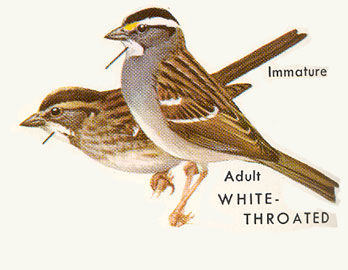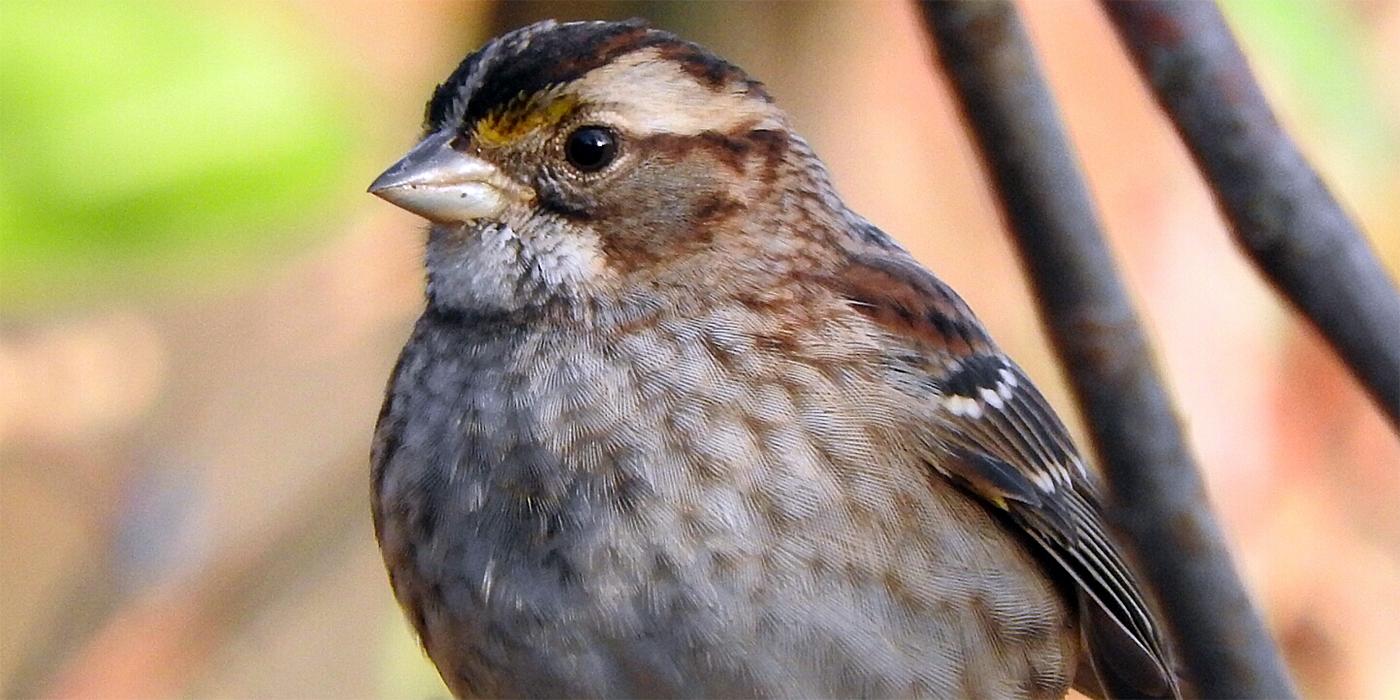A Closer Look at an Ordinary Species
White-throated Sparrow
To many bird enthusiasts, the white-throated sparrow is just an "average Joe." In fact, I suspect that few birders living in Canada and the eastern United States have celebrated the long-awaited addition of the white-throated sparrow to their life lists.
Few bird walks in the right season and habitat fail to provide a white-throated sparrow sighting. Accordingly, white-throateds are noted as "common" on most local checklists published within their range. It may be difficult for some birders to get excited about seeing the same old regular birds, but there is more to white-throated sparrows than meets the eye.
White-throated sparrows are considered a "common" species partly because they are fairly abundant and their range is reasonably wide. In contrast to many migratory bird populations, which are declining rapidly, white-throated numbers appear to be comparatively stable, or at least on only a relatively slow decline. One reason for this trend is that their habitat is currently plentiful.
In the northeastern U.S. and across most of Canada, white-throateds breed in semi-open coniferous and mixed forests that are regenerating following logging, fires, or insect damage, and where secondary growth provides a low, dense understory. With a steady demand for timber products, combined with the regular occurrence of fires (natural and human-induced) and insect damage, breeding habitat should be available to white-throateds for years to come as forests regenerate. However, the conversion of forested lands to agricultural fields does eliminate potential breeding habitats, as it does for many species.
Although urbanization in the mid-Atlantic and southeastern U.S. has engulfed much of this sparrow's winter range, they seem to have adjusted fairly well. Wintering white-throateds can often be found in suburban neighborhoods and city parks, clinging to cover provided by hedgerows, weeds, and shrubs just as they do in rural areas. White-throateds are regular visitors to yards with feeders, where they prefer to feed on seed scattered on the ground near cover.
In addition to being abundant and widespread, white-throated sparrows are easily detected by both sight and sound. White-throateds forage primarily on or close to the ground, so they are easier to spot than cryptic canopy foragers, and white-throateds can be observed for extended periods without the neck strain that accompanies canopy-bird watching.
Their song is a long, slow series of whistled notes often paraphrased as "Old Sam Peabody, Peabody, Peabody" or "Oh sweet Canada, Canada, Canada." Their song is so loud and distinct, in fact, that a novice birder can identify it even among the noisiest of morning birdsong choruses. Their frequent use of call notes, a rich "tseep" and a sharp "pink," and boisterous leaf-kicking habits give their position away while they forage in thick cover.
Winter flocks are particularly noisy when congregating at dusk for the evening roost and as they scatter from the roost at dawn to feed.
Although white-throated sparrows are indeed common, they should by no means be considered ordinary. These sparrows exhibit a characteristic that is rare in birds, they show genetically-based plumage polymorphism. In other words, these sparrows come in two different color forms, or morphs.
During the breeding season, the morphs are most easily distinguished by the colors of their crown stripes. The "white-stripe" morph typically has distinctly contrasting black and white crown stripes and bright yellow lores (the area between the eyes and the base of the bill), while the "tan-stripe" morph has duller black (or dark brown) and tan (or pale brown) stripes and less vivid lores.
Color Morphs
Although color morph can be difficult to determine in winter plumage, the polymorphism is due to chromosomal differences and does not change with age or season, although this was a common misconception among early ornithologists, as evidenced by white-throated sparrow species accounts from most field guides published before 1970.

For example, check out these images from R.T. Peterson's 1961 version of A Field Guide to Western Birds, a respected source for bird identification. Like Peterson, many thought that white-striped birds were mature adults and tan-striped birds were juveniles; others assumed white-striped birds were male and tan-striped birds were female.
“Field marks: Adult: Gray-breasted with white throat patch, striped black and white crown, and yellow spot between bill and eye. Bill blackish. Immature: Duller; head-stripes brown and buffy, but same essential pattern; bill dark.”
We now know that both male and female white-throated sparrows exhibit this polymorphism. Moreover, an individual almost always pairs with another of the opposite color morph for breeding. And despite the fact that images of the white-striped morph are more frequently presented to illustrate the species, the two color morphs actually occur in relatively equal numbers in the population.
Most interesting is that behavior differs between color morphs, especially during the breeding season. Both male and female white-stripe birds are more aggressive than tan-stripe birds. In fact, white-striped females will even sing and contribute to territorial defense, whereas tan-striped females do not. In contrast, tan-striped birds of both sexes provide more care to their young than white-striped birds do. Check out the video below from a recent study on white-throated sparrow parental behavior.
Another interesting fact is that white-striped males seek matings outside of their pair bond more often than tan-striped males, but by doing this, white-striped males lose paternity opportunities at home because they do not guard their mates as diligently as tan-striped males.
So which is the best morph? This is hard to say, but there is some evidence to suggest that females of both color morphs prefer the less aggressive, more faithful and parental tan-striped males, while males of both morphs prefer white-striped females. As is the case in many bird species, however, female choice dictates pair bonds. The more aggressive white-striped females appear to outcompete tan-striped females for access to the preferred tan-striped males, leaving tan-striped females to pair with white-striped males.
Regardless of how opposite morph pairs are formed, this mating style seems to equalize the aggressive and parental qualities of the different pair types. That is, the low aggression and high parental care of tan-striped females offsets the high aggression and low parental care of white-striped males. In pairs formed of tan-striped males and white-striped females, each seems to contribute equally to territory defense and parental care.
This morph-specific variation in behavior has drawn a great deal of attention from scientists investigating bird behavior. White-throated sparrows have been the focus of myriad ornithological studies of aggression, parental care, habitat selection, migration, mate choice, extra-pair mating, and polymorphism in birds. In addition, white-throateds have become a model species for studying the physiological mechanisms that control bird behavior. For example, recent studies suggest that behavioral differences between the color morphs are associated with morph-specific differences in hormone levels and brain anatomy.
Discoveries such as these provide new and fascinating insights into the factors that influence bird behavior, and spur further research. This common species has an uncommon amount to teach us.
